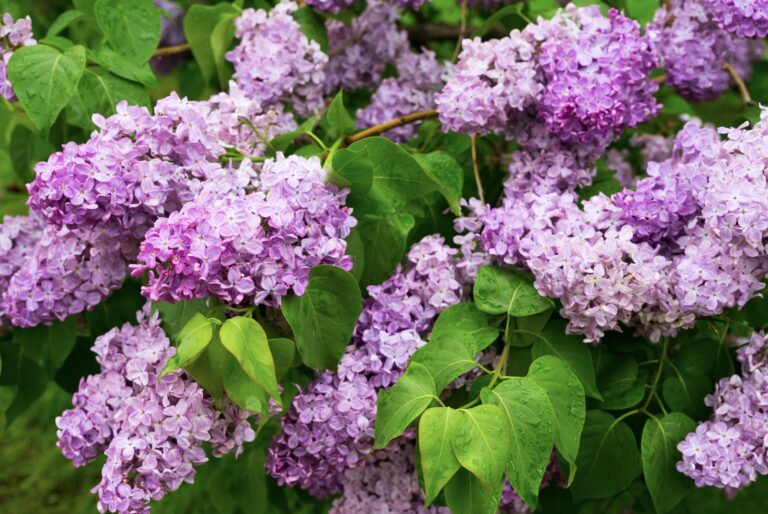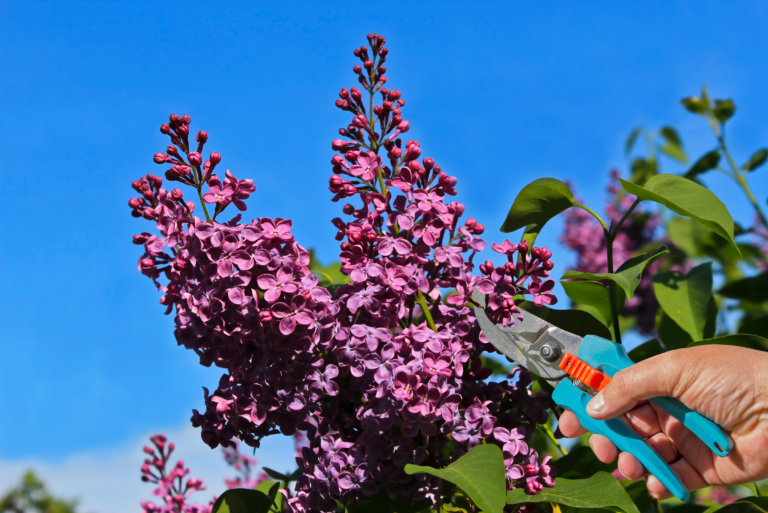Table of Contents
Lilac bushes are not only beautiful additions to any garden but also relatively easy to care for. However, to ensure they stay healthy and vibrant year after year, proper pruning is essential. In this guide, we’ll discuss when and how to prune lilac bushes effectively, providing you with 5 simple suggestions to keep your garden looking stunning.
1) When Should you Prune a Lilac?
Pruning at the right time is crucial for the overall health and blooming performance of lilac bushes. Late spring or early summer pruning, immediately after the flowers fade, is optimal because it aligns with the natural growth cycle of the bushes. During this period, lilacs are in their active growth phase, and pruning stimulates new growth while minimizing stress on the plant. By pruning right after flowering, you give the bushes ample time to recover and allocate energy towards developing strong branches and setting buds for the following year’s blooms. This timing ensures that you won’t accidentally remove flower buds that have already formed for the current season, preserving the beauty of your garden. Pruning at the recommended time also reduces the risk of pests and diseases entering through freshly cut wounds. Lilac bushes are susceptible to certain pests and fungal infections, so minimizing open wounds during vulnerable periods helps maintain their overall health. Learn more about trimming bushes here.

2) Remove Dead and Diseased Branches
Start by identifying the branches that need to be removed completely. These branches may appear discolored, brittle, or show signs of fungal growth. Using sharp and clean pruning shears, make precise cuts just above the branch collar, which is the swollen area where the branch mets the main stem or another branch. Removing dead or diseased branches not only improves the overall appearance of the lilac bushes but also promotes better air circulation and sunlight throughout the plant to make sure there is enough space for your plants to breathe. This reduce the risk of fungal infections and improves the plant’s ability to photosynthesize and thrive. When cutting back to the main stem or a healthy lateral branch, ensure that you do not leave stubs behind. Stubs can attract pests and pathogens, leading to further damage to the plant. Watch the video below to see how His Workmanship prunes lilac bushes.
3) Thinning Out for Air Circulation
Thinning out older branches in lilac bushes serves multiple purposes beyond just enhancing air circulation and light penetration. It also promotes the overall health and longevity of the plant while ensuring a more aesthetically pleasing appearance. When thinning out branches, prioritize removing about one-third of the oldest stems. These older branches tend to be less productive and may inhibit the growth of younger, more vigorous shoots. Look for branches that are crossing, rubbing against each other, or growing inward toward the center of the bush. These branches can create congestion and block sunlight from reaching the inner parts of the plant, leading to reduced flowering and potential disease issues. By pruning these older branches, you stimulate new growth from the base and outer areas of the bush. This new growth is often more robust and produces more blooms, rejuvenating the lilac bush and ensuring a continuous cycle of healthy growth.

4) Prune for Size and Shape
When tackling overgrown bushes, start by identifying the most prominent and unruly branches that contribute to the bush’s disproportionate appearance. Trim these branches back to the desired length, ensuring that your cuts are made just above a healthy bud or lateral branch junction. While it’s necessary to remove excessive growth, cutting into old wood excessively can have negative consequences, such as reducing flowering potential in the upcoming year. Lilac bushes rely on one-year-old wood for their abundant blooms, so preserving a healthy balance between old and new growth is essential for sustained flowering. As you prune, step back periodically to assess the bush’s overall shape and symmetry. Aim for a natural and harmonious appearance that complements its surroundings. By carefully shaping the lilac bushes, you not only control their size, but also create a visually appealing landscape feature that enhances the beauty of your garden. Remember to use sharp and clean pruning tools to make precise cuts and minimize stress on the bushes.
5) Minimal Pruning for Young Lilacs
In addition to minimal pruning for young lilac bushes, it’s crucial to provide proper care and maintenance to support their early growth stages effectively. Young lilacs require attention to establish a robust root system and develop a healthy framework for future growth and blooming. Aside from removing dead or damaged branches, young lilacs benefit from shaping techniques that encourage bushier growth and a well-balanced structure. Light shaping involves selectively pruning branches to promote branching at lower levels, creating a fuller and more compact appearance. This not only enhances the aesthetic appeal of the bushes but also supports a healthier and more robust overall growth pattern. When shaping young lilac bushes, prioritize removing any competing or crossing branches that may hinder proper development. Focus on maintaining an open and airy structure that allows sunlight and airflow to penetrate throughout the plant, promoting photosynthesis and reducing the risk of fungal diseases. Providing adequate water, nutrients, and sunlight is crucial for the optimal growth of young lilac bushes. Ensure they receive sufficient water during dry periods, especially in the first few years when their root systems are establishing.

Pruning lilac bushes doesn’t have to be a hassle. By following these simple suggestions and timing your pruning correctly, you can ensure that your lilacs remain vigorous, blooming beautifully each spring. Remember to use sharp and clean pruning tools, and always aim for a natural and balanced appearance when shaping your lilac bushes. Contact His Workmanship for more support on pruning, enjoy the vibrant colors and fragrant blooms of your well-maintained lilac garden!



